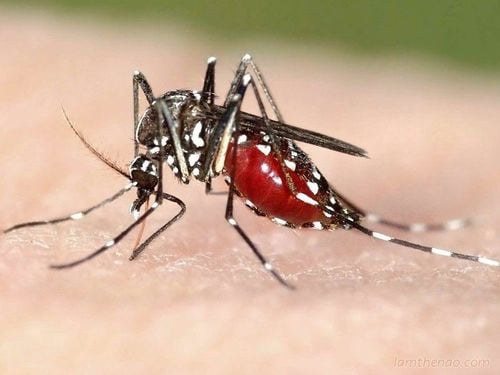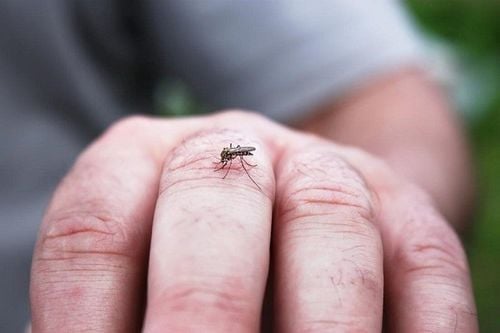This is an automatically translated article.
The article was professionally consulted with Master, Doctor Nguyen Tung Hoanh- Department of Resuscitation - Emergency - Vinmec Nha Trang International General Hospital.Dengue fever is an acute infectious disease caused by the dengue virus, which is transmitted from an infected person to a healthy person through mosquito bites. The disease can occur all year round, but most often outbreaks in the rainy season. People with Dengue hemorrhagic fever will have symptoms of fever, hemorrhage and plasma leakage, in severe cases may experience hypovolemic shock, coagulopathy, organ failure, even death if undiagnosed. timely treatment.
This article will provide readers with the necessary knowledge in the Dengue Dengue fever treatment protocol 2019 issued and adjusted by the Ministry of Health, in order to help people raise awareness when dealing with dengue fever. , avoiding the unfortunate consequences that occur due to lack of knowledge about this disease.
1. Dengue fever when to be hospitalized?
From the 2nd day of illness onward, patients with dengue fever need to be hospitalized if they have the following warning signs:Struggling, lethargic, lethargic; Severe and persistent abdominal pain or increased pain in the liver; Enlarged liver > 2cm or elevated liver enzymes ≥ 400U/L; Vomiting more than 3 times/hour or more than 4 times within 6 hours; Mucosal bleeding such as bleeding gums, nosebleeds, vomiting blood, vaginal bleeding or gross hematuria; Urinating less; HCT (Hematocrit – Ratio of red blood cell volume / whole blood volume) is high, platelets rapidly decrease ≤ 100,000/mm3.

Khi có triệu chứng chảy máu mũi ở bệnh nhân sốt xuất huyết cần được nhập viện ngay
The house is too far from the hospital, unable to be hospitalized in time if the disease worsens; The family has no conditions to keep an eye on the progress of the disease; Infants or overweight; Pregnant; Patients with chronic comorbidities (kidney, heart, liver, asthma, poorly controlled COPD, hemolytic anemia,...).
2. Dengue hemorrhagic fever treatment with warning signs
Dengue hemorrhagic fever patients will be prescribed fluids by the doctor if they have the following characteristics:Lethargy; Unable to drink water; Vomiting a lot; Stomachache; There are signs of dehydration; HCT increased. The duration of infusion usually does not exceed 24-48 hours.
In case the patient has warning signs when accompanied by wet and cold extremities; capillary filling time over 3 seconds; have manifestations of abdominal pain in the liver area, struggling, lethargy, restless; Normal or effective blood pressure = 25 mmHg is treated as dengue hemorrhagic shock.
After being hospitalized for treatment of Dengue hemorrhagic fever with warning signs, the doctor will advise the patient the following:
How to care at home: Pay special attention to how to eat, drink and reduce fever; Symptoms that need immediate re-examination: Vomiting a lot, fever is gone, but the person is still lethargic, tired, cold hands and feet, bleeding,...; Re-examination by appointment: Check every day until the fever is gone for more than 48 hours (>N7).

Triệu chứng hết sốt nhưng người vẫn lừ đừ, mệt lạnh cần được tái khám lại ngay
3. Treatment of Dengue hemorrhagic fever shock
Note that patients with dengue shock are often still awake, if they do not monitor the capillary filling time, pulse, and blood pressure, it will not be possible to detect dengue shock early for timely treatment, potentially causing many problems. risk to the patient's life; The infusion solutions to be prepared include: Ringer lactate; Ringer acetate in case of severe liver damage or acute liver failure; Isotonic saline solution Nacl 0.9%; Macromolecular solution (dextran 40 or 70, hydroxyethyl starch (HES 200,000 dalton); Albumin solution; Nasal oxygen 1-6 liters/min; Rapid fluid resuscitation.
Bù dịch nhanh điều trị sốt xuất huyết Dengue
4. When to stop the infusion?
Doctors will base on the following factors to decide to stop infusion for patients with dengue shock:Clinically stable, patient has warm limbs, clear pulse, stable blood pressure, good urine; Stable hematocrit; The time to stop infusion is usually 24 hours after the shock is gone and the patient shows signs of recovery, usually after the 6th or 7th day. The total infusion is usually 120-150ml/kg in this case. patients with dengue hemorrhagic fever; and in case of severe dengue hemorrhagic fever, the infusion time and total fluid may be higher; Stop the infusion when the patient shows signs of overload or pulmonary edema.
5. In what case is blood transfusion and blood products indicated?
For fresh frozen plasma: Indicated in the case of patients with coagulopathy (PT or aPTT>1.5) and heavy bleeding; or the patient has a coagulopathy and is preparing for the procedure; Target to be achieved: PT/PTc < 1.5. For cold precipitation: Indicated in the case of patients with heavy bleeding and fibrinogen < 1g/l; Target to be achieved: Fibrinogen > 1g/l. For platelets: Indicated in the following cases: TH1: Platelets < 50,000/mm3 and heavy bleeding; TH2: Platelets <5,000/mm3, no bleeding: Consider on a case-by-case basis; TH3: Platelets < 30,000/mm3 and preparation for invasive procedure (except emergency). Targets to be achieved: TH1: Platelets > 50,000/mm3; TH3: Platelets > 30,000/mm3. For erythrocyte sedimentation, fresh blood: Indicated in cases of patients with severe/prolonged bleeding or shock that does not improve after 40-60ml/kg fluid resuscitation + HCT <35% or HCT rapidly falls below 20% compared with with the initial value. In addition, erythrocyte sedimentation should be given when fluid overload is suspected; Target to achieve: HCT from 35-40%.
Trao đổi với bác về các chỉ định truyền máu và các chế phẩm máu phù hợp
6. Guidelines for the management of dengue hemorrhagic shock with accompanying hemorrhagic fever
Principles of treatment: Early detection of shock, correct treatment regimen and close monitoring of patients to avoid complications such as re-shock, prolonged shock.Clinical manifestations: Fast, light pulse, difficult to catch; Clamp blood pressure ≤ 20mmHg, cold hands and feet, skin color recovery time > 3 seconds, restlessness or lethargy, little urination.
Treatment procedure:
Continue anti-shock with electrolyte solution (while waiting for red blood cells to settle); Infusion of erythrocytes 5-10 ml/kg; Correction of blood clotting disorders; Treatment of hemostasis: In-situ compression bandages, anterior/posterior nasal meche insertion, endoscopic interventional hemostasis of the stomach, duodenum,...; Consider using a proton pump inhibitor if the patient presents with findings suggestive of upper bleeding or a history of peptic ulcer disease; Consider use of vitamin K if the patient presents with severe hepatic impairment.

Truyền hồng cầu lắng khi bệnh nhân sốt xuất huyết Dengue có xuất huyết đi kèm
7. Treatment of metabolic acidosis, hypoglycemia, hypocalcemia, hyponatremia
Metabolic acidosis (pH < 7.2 and/or HCO3 - < 15): Sodium bicarbonate 4.2% 2ml/kg TMC; Hypoglycemia (blood sugar < 40 mg/dl): Dextrose 30% 1-2 ml/kg IV; Hypocalcemia (Ionized Calcium <1 mmol/L): Calcium chloride 10% 0.1-0.2 ml/kg (maximum 2-5ml/dose), diluted in 5% Dextrose 10-20ml TMC 5- 10 minutes; Severe hyponatremia with impaired consciousness (blood sodium <130mEq/l): Sodium chloride 3%: 4ml/kg IV over 30 minutes, repeat as needed.8. Case of cerebral dengue hemorrhagic fever
Patients are diagnosed with cerebral Dengue hemorrhagic fever if they have impaired consciousness, convulsions or focal neurological signs.In this case, the treatment regimen is as follows:
Place the patient's head at a height of 30o; Give oxygen; Anticonvulsants (if any): Diazepam: 0.2 mg/kg IV, 0.5 mg/kg rectally if not possible. If there is no effect, repeat for a second time after 10 minutes, up to a maximum of 3 doses. If all else fails, add Phenobarbital 10-20 mg/kg IV over 15-30 minutes; Treatment of hypoglycemia (if any): Dextrose 30% 1-2ml/kg. For children under 1 year old, Dextrose 10% 2 ml/kg; Correction of electrolyte disorders - acid-base; Anti-cerebral edema: Indicated this method when the patient has clinical signs of increased intracranial pressure: Infusion of Mannitol 20% 0.5g/kg/time or/and Sodium chloride 3% 4ml/kg/time IV 30 minutes, repeat every 8 hours; Intubation with mechanical ventilation: Increase ventilation to keep PaCO2 30 - 35 mmHg; Paracetamol 10-15mg/kg/time, 4 times a day if there is fever.

Đặt nội khí quản thở máy nhằm tăng thông khi trong sốt xuất huyết Dengue thể não
9. Conditions for hospital discharge
Patient no fever for 2 days, sober; Normal pulse and blood pressure; No dyspnea or respiratory distress due to peritoneal or pleural effusion; Platelet count tends to recover > 50,000/mm3. Dengue fever, if not detected early and properly treated, can progress to severe dengue, causing heavy bleeding, a sudden drop in blood pressure (shock) and death. Therefore, patients with suspected initial signs of dengue fever should not be subjectively treated at home, but should see a doctor soon to be prescribed the most appropriate treatment method, to avoid serious consequences. unfortunately can happen.Please dial HOTLINE for more information or register for an appointment HERE. Download MyVinmec app to make appointments faster and to manage your bookings easily.













